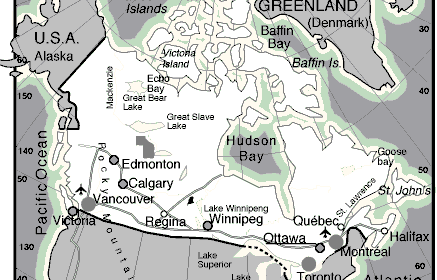
Return to * Top Ten *RIC Main Page * Background Info
Canada
Background Information

Basic Indicators
Population |
29.12 million |
Pop. Growth |
1.18% |
Land Area |
9.2 mill sq km |
GNP per capita |
19,510 current US$ |
Life Expectancy |
79 years |
ENVIRONMENT
Canada is the second largest country in the world in land area, divided into five natural regions. The Maritime Provinces along the Atlantic coast are a mixture of rich agricultural land and forests. The Canadian Shield is a rocky region which is covered with woods and is rich in minerals.To the south, along the shores of the Great Lakes and the St. Lawrence River, there is a large plain with fertile farmlands, where over 60% of the population is concentrated, and the major urban centres are located. Farming (wheat, oats and rye), is the mainstay of the Central Prairie Provinces. The Pacific Coast is a mountainous region with vast forests. The “Great North“ is almost uninhabited, with very cold climate and tundra. There are ten provinces, and two territories; the Yukon and Northwest. These are working towards provincial status, but this is complicated by Native Land claims. Canada has immense mineral resources; it is the worlds largest producer of asbestos, nickel, zinc and silver and the second largest of uranium. There are also major lead, copper, gold, iron ore, gas and oil deposits. Its industry is highly developed. Industrial emissions from Canadian and US plants contribute to the “acid rain“ which has affected thousands of lakes. The construction of a number of hydroelectric plants in Quebec is threatening to destroy the lands and livelihood of the indigenous population.
SOCIETY
Peoples: There are about 800,000 Native Americans, “Metis“ (mixed race) and Inuit ("Eskimos") ranging from highly acculturated city-dwellers to traditional hunters and trappers living in isolated northern communities. There are six distinct culture areas and ten language families; many native languages such as Cree and Ojibwa are still widely spoken. About 350,000 native people are classified as such: that is, they belong to one of 573 registered groups and can live on a federally protected reserve (though only about 70% actually do so). “Metis“ and those who do not have official status as “native people“ have historically enjoyed no separate legal recognition, but attempts are now being made to secure them special rights under the law. Languages: English and French, official. 13% of the population is bilingual, 67% speak only English, 18% only French, and 2% speak other languages (Italian, German and Ukranian). Religions: Roman Catholic 45.7%; Protestant 36.3%; Eastern Orthodox 1.5%; Jewish 1.2%; Muslim 1.0%; Buddhist 0.7%; Hindu 0.6%; nonreligious 12.4%; other 0.6%. Political Parties: The Liberal Party; the Conservative Party; Bloque Quebecois; the New Democratic Party. Social Organizations: The Canadian Labour Congress, with over two million members, is the largest trade union; The Assembly of First Nations.
THE STATE
Official Name: Canada. Administrative Divisions: 10 Provinces and 2 Territories. Capital: Ottawa, 920,857 inhab. (1991). Other cities: Toronto, 3,893,046 inhab., Montreal, 3,127,242 inhab., Vancouver, 1,602,502 inhab. (1991). Government: Ramon J. Hnatyshyn, Governor-General. Jean Chrétien, Prime Minister and head of government. Canada is a federation of ten provinces and a member of the British Commonwealth. The system of government is parliamentary. National Holiday: July 1, Canada Day (1867). Paramilitaries: 6,400 Coast Guard.
Source: World Guide 1997/98 courtesy of New Internationalist
Return to * Top Ten *RIC Main Page * Background Info